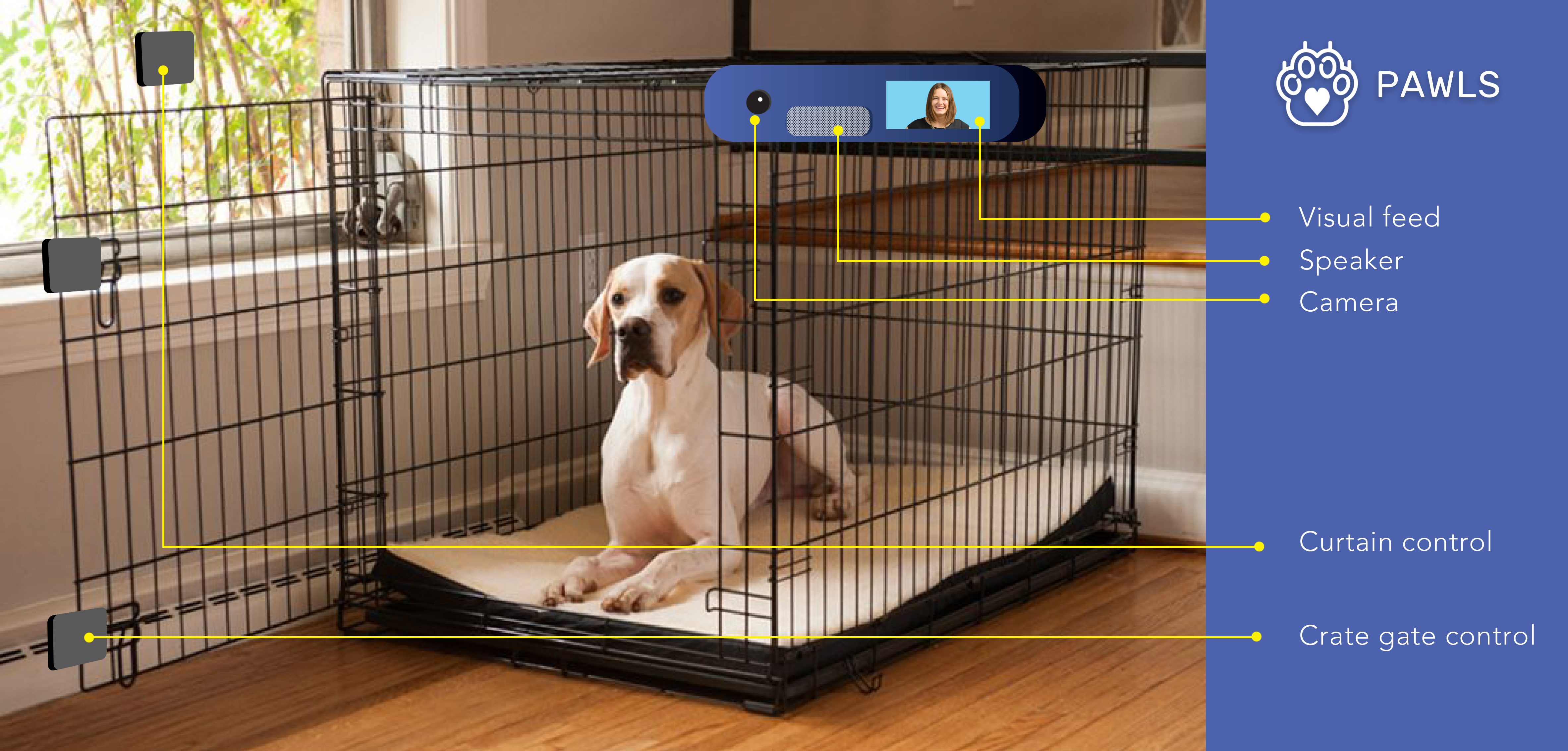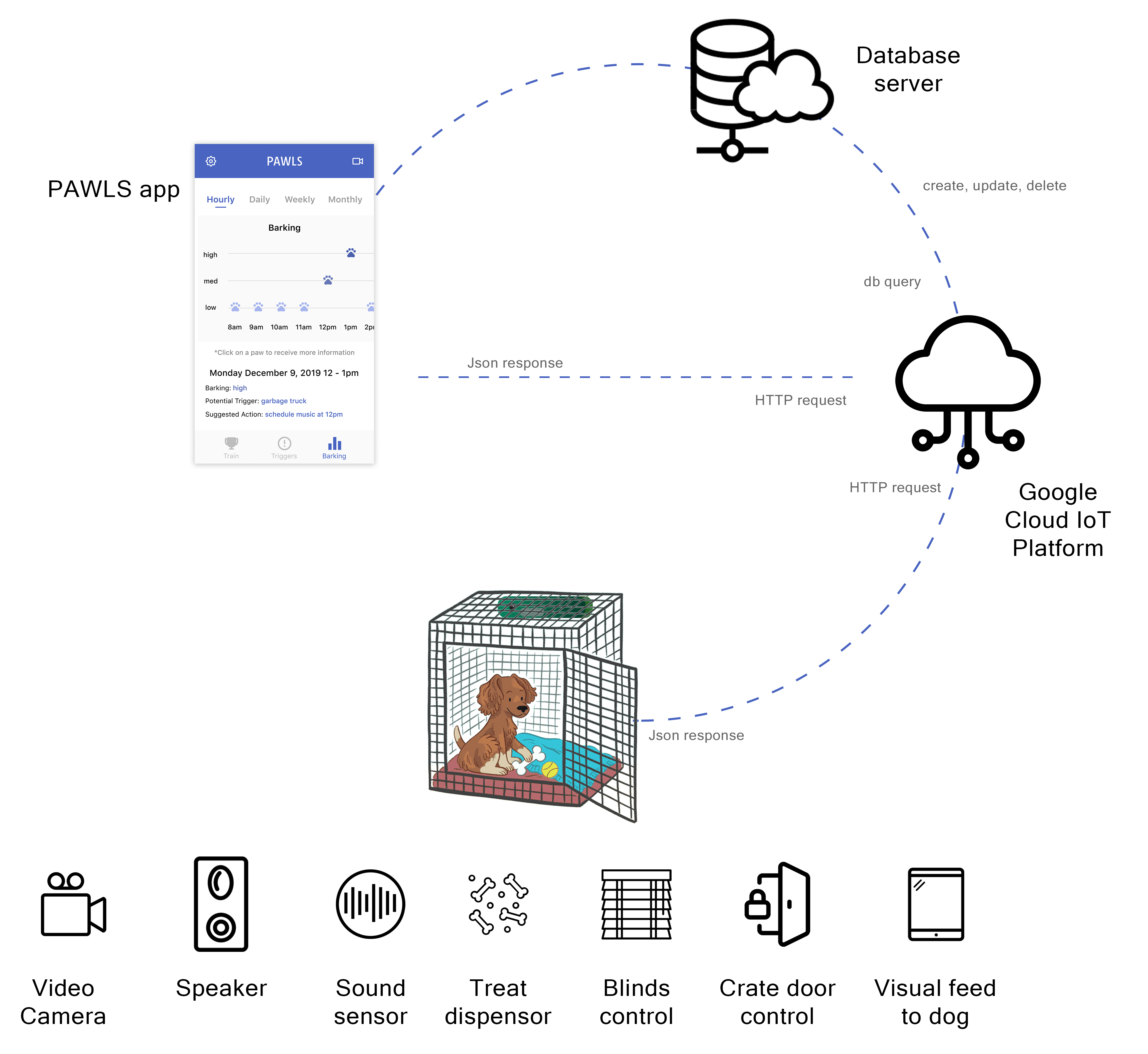
A smart crate system that decreases disruptive barking in dogs using positive reinforcement and stimulus masking methods.

Team
4 UMSI Students
Duration
September - December 2019
Role
UX Researcher & Designer
Skills
Literature review, Contextual Inquiry, Ideation, Survey, Diary Studies, Affinity Map, User enactments, Prototyping, Interaction Prototype, Arduino
Tools
Figma, Adobe Illustrator, Adobe Photoshop, Rasbian OS, Motion Camera Software
PAWLS is essentially a smart crate system that decreases disruptive barking in dogs using positive reinforcement and stimulus masking methods. It can collect data about a dog’s barking, collect information about what triggered the barking, and is capable of coming up with personalized recommendations for users detailing steps that the owner can take to aid the training.
There are two components to Pawls, the physical crate that uses pervasive technology and the mobile app which gives users the power to access all the collected data in digestible form and allows them to control the crate.
How can ubiquitous computing assist in training and mitigating behavioral issues like barking in adopted dogs?

In order to decrease the disruptive barking, we proposed a system that contains a physical crate that uses pervasive technology and the mobile app which gives users the power to control the crate.

Crate action notify's user of dog's barking, and allows the users to mitigate the situation using various features. Features like speaker, treats, blinds and music help calm down the dog. Visual feed helps user understand the situation at home. This app page is designed for quick actions.
After researching various IoT microcontrollers, our group decided on utilizing a Raspberry Pi 3 Model B+ instead of an Arduino or Particle Board. The Raspberry Pi’s quad-core processor is best suited for processing and streaming high-definition video. The Raspberry Pi’s extensive DIY community helped guide our software implementation, which involved running open-source “Motion” software, which offers extensive options related to recording video streams. We also needed to identify a camera that could record the entire area within a kennel using a fish-eye style lens. Materials needed were Cardboard, Raspberry Pi 3 Model B+, Night Vision Fish-eye Camera Module, and Bluetooth Speaker. Software needed were Raspbian OS, and Motion Camera Software.

Using semi-structured interviews, literature reviews, and informal observations, we developed the following key findings:
1. What kind of behavioral issues do dog owners typically deal with?
2. What typically triggers a behavioral issue with the dog?
3. Have dog owners conducted any training or coaching with their dog?
4. How do dog owners address behavioral issues?
5. Where do dogs normally feel safe?
Survey helped us get an idea of how we can further define our scope and concepts by focusing on what specific behavioral issues dog owners are dealing with, and how commonly they occur.
Our goal was to understand how dog owners addressed behavioral issues right as they were occurring, along with their frequency. For five days, 2 participants recorded dozens of entries in a behavioral log every time a dog experienced any emotional distress.
The first part of the diary study allowed us to better understand each dog’s unique history and temperament. In the second part of the diary study, participants were tasked with keeping a behavioral log of every instance of their dog experiencing any distress, when and where it occurred, what triggered the dog’s response, how serious the dog’s response was, and what the owner’s did about the dog’s distress.
The diary study was analyzed by breaking down every component of the behavioral log, including each specific trigger, location, the dog’s response, and how the owner responded to the dog’s inappropriate behavior. We used Trello to create an affinity board to help organize common themes between the participants and their dogs.
To narrow our scope, we elected to just focus on discouraging dogs’ disruptive indoor barking rather than try to target all behavioral issues since aggression involved more variables such as another animal. Using positive reinforcement and stimulus masking methods, we hope that our solution will train the dog when the owner is not home to provide the training themselves.
We made sure that our product had following criterias which we defined using our previous research:
Our experience prototyping study involved conducting five user enactments with each of our five participants for a total of 25 user enactments to answer our four research questions. Through the user enactments, we wanted to understand users’ perception and the strengths and weaknesses of our product in varying scenarios.
1. What smart crate features do users see themselves using at home versus when they are away from their home?
2. Does the smart crate feel invasive?
3. How much remote interactivity and automation do owners expect from their smart kennel?
4. What kind of information should be regularly available from their mobile devices?
Findings and Design Implications
While earlier research informed us about user’s general pain points, it was in this stage of our research that we were able to directly observe users interacting with our product in the way they would in their home. As a result, we were able to observe the user's authentic reaction to our suggested features, rather than our abstract ideas or hypotheticals. It was these reactions that helped us gain a more accurate understanding of if and how our ideas were addressing user needs and the pain points we had previously identified.
Owners would like to have more control over the system, and rely less on automationSetup should include features to learn about user's preferences, notify users, and give control over actions.
Being unable to react is just as bad as being uninformedNotifications should be solution-oriented and give the owner a sense of agency
Data is kingDisplay information in an easy to read visualizations, and show progress.
The system should train the owner as much as it trains the dogData gathered should recommend yours about future plan of action, and educate users.
We are proposing a smart kennel that will help facilitate crate training with the dog owner. The smart kennel will allow users to interact and monitor their dog from anywhere in the world from their smartphone or tablet. Initially, the smartphone app will walk the dog owner through various The smart kennel will allow the user to track and analyze the dog’s emotional triggers, as well as remotely control various functions, including accessing the live camera, playing music or their voice through the smart kennel’s speaker, and dispersing a dog’s treat.
Story 1 :Our first storyboard depicts a user when she first gets the Dog House and she is unsure of how she wants to use the automated features of the system. She opens the companion smartphone app to begin setup, and discovers that the onboarding process in the app presents her with scenarios in which the system could take action, and lets her choose the option that best fits her needs. Upon completing the setup process, she is confident that the system will now meet her needs and that she has set it up just the way she likes it.
Story 2 :In our second storyboard, we can see how the system gives the owner the option to respond and makes recommendations for how to do so. Our user has a guest over, and her dog is barking and acting out now that there is a new person in the house. She realizes that her dog is stressed and her guest is uncomfortable, but isn’t sure what to do to resolve the situation. Detecting the dog’s movement and stress levels through its sensors, the DH sends her a notification for what she can do. The system recommends she places the dog in the crate and activates two calming features, and she follows through and does these things. When she’s doing them, she feels more empowered since the system gave her suggestions but let her make her choice.
As this project was a part of my Master's curriculum, a lot of decision making that we did will not fit in industry scenario. Our coursework needed us to use certain methodologies to conduct research.
In this section I address a few assumptions and constraints related to this project.
↳ Dogs are crate trained
↳ This solution works for all dogs
↳ User is well versed with the technology
↳ Dogs should be crate trained
↳ Availability of proper devices
↳ For features like blinds and noise control to work, the IOT system has to be integrated well with the existing system
↳ The solution prototype was never tested with any user (humans or dog)
Dogs might not be accustomed to crate training or worse, the crate can be a source of negative and hostile feelings for the dogs. When the owner is not home, PAWLS is most effective once the dog is lured into the crate, but is not effective when the dog is not. Trying to lure the dog into the crate might be more difficult in real life filled with many variables. Connect with sensors within and outside the home, rather than just solely rely on sensors within the smart crate.